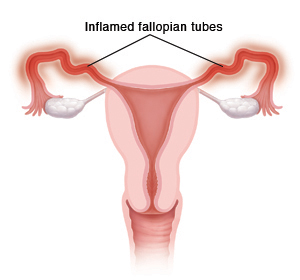Acute Salpingitis
Acute salpingitis is an infection of the fallopian tubes. These tubes carry the eggs from the ovary to the uterus. Pelvic pain is the main symptom of acute salpingitis.

What causes acute salpingitis?
An infection in the vagina or cervix often causes salpingitis. If this infection travels up into your uterus (womb), it can reach your fallopian tubes. You may get the infection, such as chlamydia or gonorrhea, by having sex with someone who is infected. A surgery or a procedure, such as childbirth or insertion of an IUD, can also cause acute salpingitis. But this is rare. Salpingitis most commonly happens to women who are young and sexually active. But it can happen in women of any age.
Salpingitis is also called pelvic inflammatory disease (PID). PID means that there is an infection and inflammation in any of the reproductive organs. Acute salpingitis is the specific term for infection of the fallopian tubes.
What are the symptoms of acute salpingitis?
Some women with acute salpingitis have symptoms such as:
Some women may have no symptoms at all.
How is acute salpingitis diagnosed?
There is no single test to diagnose salpingitis. Instead, your healthcare provider performs different tests to rule out other problems. First, your healthcare provider does a pelvic exam and asks about your symptoms and health history. Then, you will probably have one or more of the following tests:
-
Urine test to check samples of your urine for signs of infection
-
Blood tests to check samples of your blood in the lab for problems
-
Vaginal or cervical swabs to take samples and check them for infection
-
Pelvic ultrasound to look at images of your pelvic organs
-
Endometrial biopsy to take a sample of cells from the inside of your uterus and check them for infection
-
Laparoscopic surgery may be needed in some cases to diagnose or treat acute salpingitis
Treating acute salpingitis
To treat the infection, your healthcare provider will give you antibiotics. If the infection is mild, you will be able to take these at home. Take all the medicine as directed until it's gone, even if you feel better. In some cases, you may also get an injection of medicine. If the infection is severe, you may need to stay in the hospital. This is so you can get antibiotics through an IV line. In most cases, antibiotics will cure the infection. Sometimes surgery is needed to treat the infection.
Follow-up care
If you get treatment right away, salpingitis can be cured. Be sure to keep your follow-up appointment with your healthcare provider to be sure your infection is gone. Sexual partners of women with acute salpingitis may also need to be tested for infection, even if they have no symptoms. Treatment is important to prevent reinfection. If you are having trouble getting pregnant, you may have tests to check for any damage to your fallopian tubes from the infections.
When to call your healthcare provider
Call your healthcare provider right away if you have any of the following symptoms:
-
Fever of 100.4° F (38°C) or higher, or as directed by your healthcare provider
-
Painful or frequent urination
-
Pelvic pain that doesn’t go away or gets worse
-
Vaginal discharge with a bad odor
-
Vomiting that prevents you from taking antibiotics